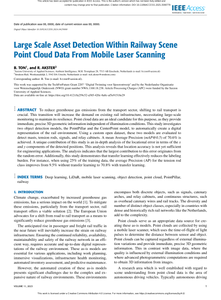A small dataset containing 15 high resolution point clouds of catenary arches is provided. The number of points per arch ranges from 1.6 M to 11 M points. They have been manually labelled into 14 distinct classes.
DOCUMENT
‘Bedrijfsprocessen uit de cloud, business rules als succesfactor’ is een publicatie van het Platform Outsourcing Nederland en is het verslag van een onderzoek van de Hogeschool Utrecht, Lectoraat Extended Enterprise Studies, die tot stand is gekomen met een subsidie van het PON (Platform Outsourcing Nederland).
MULTIFILE

aving access to accurate and recent digital twins of infrastructure assets benefits the renovation, maintenance, condition monitoring, and construction planning of infrastructural projects. There are many cases where such a digital twin does not yet exist, such as for legacy structures. In order to create such a digital twin, a mobile laser scanner can be used to capture the geometric representation of the structure. With the aid of semantic segmentation, the scene can be decomposed into different object classes. This decomposition can then be used to retrieve cad models from a cad library to create an accurate digital twin. This study explores three deep-learning-based models for semantic segmentation of point clouds in a practical real-world setting: PointNet++, SuperPoint Graph, and Point Transformer. This study focuses on the use case of catenary arches of the Dutch railway system in collaboration with Strukton Rail, a major contractor for rail projects. A challenging, varied, high-resolution, and annotated dataset for evaluating point cloud segmentation models in railway settings is presented. The dataset contains 14 individually labelled classes and is the first of its kind to be made publicly available. A modified PointNet++ model achieved the best mean class Intersection over Union (IoU) of 71% for the semantic segmentation task on this new, diverse, and challenging dataset.
DOCUMENT
To reduce greenhouse gas emissions from the transport sector, shifting to rail transport is crucial. This transition will increase the demand on existing rail infrastructure, necessitating large-scale monitoring to maintain its resilience. Point cloud data are an ideal candidate for this purpose, as they provide immediate, precise 3D geometric information independent of illumination conditions. This study investigates two object detection models, the PointPillar and the CenterPoint model, to automatically create a digital representation of the rail environment. Using a custom open dataset, these two models are evaluated to detect masts, tension rods, signals, and relay cabinets. A mean Average Precision (mAP@0.5) of 70.6% is achieved. A unique contribution of this study is an in-depth analysis of the locational error in terms of the x and y components of the detected positions. This analysis reveals that location accuracy is not yet sufficient for engineering applications. The analysis indicates that the largest contribution to this error originates from the random error. Additionally, this study demonstrates that transfer learning effectively reduces the labeling burden. For instance, when using 25% of the training data, the average Precision (AP) for the tension rod class improves from 9.5% without transfer learning to 70.8% with transfer learning.
MULTIFILE

Schepen in moeilijkheden op zee leveren vaak besluitvormingsproblemen op tussen de scheepseigenaar/kapitein en de kuststaat. Kuststaten en met name de lokale overheden willen een probleem schip graag zo ver mogelijk weg sturen van hun gebied terwijl de eigenaar/kapitein zijn schip graag zo snel mogelijk naar de kust, een beschutte locatie of haven wil brengen. Het onderzoek geeft onderbouwing voor de besluitvorming rond schepen in moeilijkheden, zowel voor de zeescheepvaart als de betrokken besluitvormers van oeverstaten. Het product van het project is: een, op uitgewerkte scenario’s per scheepstype en lading gebaseerde besluitvormingsprocedure voor zeeschepen in moeilijkheden
DOCUMENT

Technologische vooruitgang dient twee tegengestelde verlangens. Het verlangen van de ultieme controle over de werkelijkheid en het verlangen naar afstand tot diezelfde werkelijkheid. Het verlangen naar grip en verlichting. Het verlangen naar macht en virtualisering. Dat zijn oude verlangens, die al eeuwen leven in de mythes rond 'de golem' en de mythe van 'de engelen'. De geschiedenis van de technologische vernieuwing laat zich lezen als een verhaal van steeds meer ingrijpen in de werkelijkheid, en tegelijkertijd als een terugtrekkende beweging uit die werkelijkheid. Elke technologische vooruitgang versterkt dat spanningsveld. En omdat digitale technologie met een logaritmisch versnelling vooruit dendert, wordt die kloof in het verlangen pijlsnel groter. Bioproducten online bestellen met je iPad. De beelden van je trektocht door ongerept natuurgebied online bewaren in ‘the cloud’. Een actiegroep voor het behoud van een exotische, uitstervende diersoort op facebook… De samenleving heeft behoefte aan nieuwe mythes waarrond ze de wijzigende structuren kan organiseren. Het zijn mythes die ons laten samenwerken - of het nu om een religie gaat, de mythe van de waarde van geld, de mythe van gerechtigheid, van democratie… Kunstenaars leven in de dynamiek van de samenleving. Hun werk is ook onderhevig aan de dwang van technologische vooruitgang. Maar door een stap achteruit te zetten, afstand te nemen en kritisch te kijken naar een logaritmisch snel veranderende samenleving, kunnen ze nieuwe verhalen scheppen, nieuwe wegen tonen, nieuwe beelden, nieuwe mythes... Net zoals de beelden van engelen en de verhalen van de golem uit de middeleeuwen (en daarna) krachtige, tijdloze mythes toonden. Omdat de computer onvermijdelijk beter wordt in alles wat objectief meetbaar is (dat is bijna een tautologie), wordt de skill van het creatieve denken, van het ongedachte bedenken... 'the unique selling point' van de mens. Kunst heeft niet alleen toekomst. Het is de toekomst.
DOCUMENT
